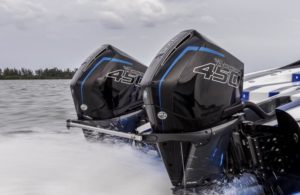
Photo Credit Mercury Racing
The dyno or dynamometer is a tool used to measure torque against rotation and rotational speed to calculate horsepower. Mercury Racing is dedicated to trusting technology and has a dyno they use on their engines. Keep reading the article below to find out more about the dyno. TNT Custom Marine is proud to be a preferred Platinum Mercury Racing dealer, providing the very finest service and rigging in the industry.
Mercury Racing trusts technology and believes in the accuracy of all the cutting-edge computer-driven design tools at its disposal. The computer predicts the power potential of a new engine or an updated design. But that digital prediction is verified in the real world using a dynamometer, one of the most important tools in the Mercury Racing shop.
A dynamometer, or dyno, is a tool used to simultaneously measure torque against rotation and rotational speed (rpm), which is then used to calculate horsepower. The dyno can be used to generate a map of horsepower and torque curves, either through a transient sweep through the rpm range or through discrete steady-state points. For power development, Mercury Racing relies on steady-state, point-by-point power curves where the engine is held at wide-open throttle to saturate oil, air, and water temperatures.
Dynos at Mercury Racing are almost always in use. Mercury Racing technicians will often build the engine, instrument it, rig it on the dyno, run the dyno, and calibrate or develop the engine. The dyno is a primary development tool for Mercury Racing engine programs.
“Performance predictions, analysis in GT-Power, and computer simulations are qualified and refined by dyno data so that future predictions are more accurate,” said Mercury Racing Development Engineering Manager Chris Jenks. “A moderately instrumented engine for calibration will have about 40 thermocouples in air, exhaust, and water, and 20 pressure transducers reading everything from air-intake pressure at multiple points to exhaust backpressure to water pressures in the block and cylinder heads. Air, fuel, water, and blow-by flow rates are all measured. There are eight in-cylinder combustion pressure transducers that can be used for real-time monitoring of cylinder pressure in .10-degree increments, a useful tool for balancing cylinders and working to the edge of normal combustion. Typically, there are more than 400 raw or calculated channels of data are being recorded, reviewed, or monitored as shutdown limits as we work through development or are optimizing the calibration for an engine. The dyno allows us to run the engine consistently, week after week, at every operating point at which a customer can run the engine, and at some, they can’t.”
Jenks explains that calibrating an engine is a circular process that is similar to painting a car, in which each layer of paint is followed by wet sanding and buffing to make the entire surface smoother. It’s a complex, time-consuming process. For example, there are 916 maps or required control inputs that build the calibration in the ECU (engine control unit) that operates the Mercury Racing 450R outboard. Sixty-three of those are considered base maps, whose foundation is relied on for the rest of the calibration. Those base maps contain 18,207 cells that represent roughly 7,000 discrete running conditions (rpm, load, engine temperature, ambient conditions), which are run on the dyno to rough map, check, and re-check for errors and interactions. Final calibration checks before production will go through each of those 18,000 cells point by point.
In addition to engine development, the dynos are sometimes used for outboard exhaust emissions or power audits before they leave for customers. Warranty returns, although rare, are run on the dyno to re-create the complaint and diagnose the root cause. All sterndrive engines are run on the dynos for break-in and a power-verification run before shipping.
Dyno development allows Mercury Racing to run an engine in a laboratory setting that captures all the extremes our customers are likely to dole out on the water. The result is a high-performance marine engine product that is powerful, reliable and refined.
Original article published on mercuryracing.com






